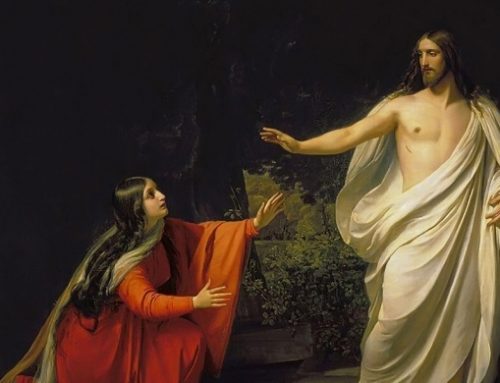How did the Early Christians live the Easter Season?
The celebration of the Pasch was extended all throughout Easter time. The 50 days that follow the Resurrection of Jesus Christ on Easter Sunday until Pentecost Sunday are celebrated with enormous joy, as if it were one big feast day, like “one great Sunday”.
Once concluded the celebration of the Easter Vigil of the Resurrection, the Easter Seasonbegins, which commemorates the Resurrection and the Glorification of our Lord Jesus Christ, the descent of the Holy Spirit, and thestart of the activity of the Church. At the same time, it also anticipates the eternal glory that is to come at the end of time.
The Easter Season is composed of fifty daysthat follow the Resurrection of Jesus Christ on Easter Sunday and finally conclude with Pentecost Sunday. In a way, it can be considered “one big feast day”: the Great Sunday. (St. Athanasius, Epist. Fest. 1)
The origins of the fifty-day celebration were patterned after the annual celebration of the Pasch: in the beginning, the Pasch was observed as a feast that usually extended for 50 days.
The paschal octave
The first eight days of Easter form the Paschal Octave, which are all celebrated as days of Solemnity of our Lord. The celebration of this particular week –in albis as designated in the Roman rite- was formally started in the fourth century AD in order to serve as catechesis for newly baptized faithful about the divine mysteries that they had just experienced. The Sunday that ends the Paschal Octave constitutes the next most solemn day of the liturgical year after Easter Sunday. As Benedict XVI explains, “This Sunday concludes the Octave of Easter. It is a unique day “made by the Lord”, distinguished by the outstanding event of the Resurrection and the joy of the disciples at seeing Jesus. Since antiquity this Sunday has been called in albisfrom the Latin name, alba, which was given to the white vestments the neophytes put on for their Baptism on Easter night and took off eight days later, that is, today.” (Homily, Easter Sunday, 11-IV-2010)
Pentecost
The celebration of the last day of the Easter Season, Pentecost Sunday, started at the end of the third century, originally influenced by the homonymous Jewish feast. In the fourth century, the feast of the Pentecost began to be celebrated for two reasons: the Ascension of our Lordand the Descent of the Holy Spirit, as attested to by testimonies of the Church of Jerusalem. However, little by little, as the Church started to put more focus on the single, historical salvific actions of Christ, the feast was further broken down. The Feast of the Ascension started to be celebrated on a separate day: i.e., the 40th day after the Resurrection.
Finally, during the seventh and eighth centuries, the Roman Church added to the Feast of the Pentecost another Octave similar to the Paschal Octave, thus breaking the fifty-day celebration of the Easter Season. Its origin can be traced to the same desire to give a catechesis to those who were baptized on Pentecost. This additional Octave was later on discontinued by the reform of the liturgical calendar (the current one) since it somewhat diminished the meaning of the Easer Season.
The liturgical texts of the Feast of the Ascension recall the historical fact of the ascent of Christ to heaven, and at the same time, serves as an anticipation of the second coming of Christ and the glorious exaltation of man. On the other hand, the Feast of Pentecost shows the intimate relation between the Resurrection of Christ and the coming of the Holy Spirit. In fact, the whole Easter Season is considered proper of the Holy Spirit.
Baptismal Renewal
On the first three Sundays of Easter, the Gospel readings are reserved to those telling of theapparitions of the Resurrected Lord; while on the fourth, to the Parable of the Good Shepherd and the Priestly Discourse of Christ after the Last Supper, as read from theGospel of Saint John. On the other hand, the first and second readings on these Sundays are all taken from the New Testament: the first readings from the Acts of the Apostles while the second readings from the First Epistle of Saint Peter, the First Epistle of Saint John or Revelation.
With all this tradition, the Easter Season emphasizes the baptismal renewal of the Christian life, intimately rooted in the good news brought by the Resurrection. The Church sees herself as the continued presence of Christ, animated by the dynamism of the Spirit, in anticipation of the second and definitive coming of Christ.
During the Easter Season, Christians are called to reflect on their new livesas seen in light of the Paschal mysteries. This way, in everyday circumstances, the faithful can discover the real presence of the Resurrected Christ who calls them to become witnesses and give witness to him before all men.
The Easter Season starts on Easter Sunday and ends on Pentecost Sunday. The first week constitutes the Easter Octave and is celebrated as a Solemnity of our Lord. In those places where the Feast of the Ascension of our Lord cannot be celebrated on a Thursday, it is moved to the seventh Sunday of Easter. The Sundays of the Easter Season takes precedence over all other feasts and solemnities, which in these cases are moved to the following Monday. White is the color used in the Easter Season.
References:
1. Saint Athanasius. Epist. Fest. 1. Cfr. Roman Calendar, Universal norms of the liturgical year and calendar 22; Letter about Easter feasts (16-1-1988) 100.
2. Cfr, Roman Calendar, Universal norms about the liturgical year and calendar 24.
3. Cfr, Roman Calendar, Universal norms about the liturgical year and calendar 25.








Leave A Comment
You must be logged in to post a comment.